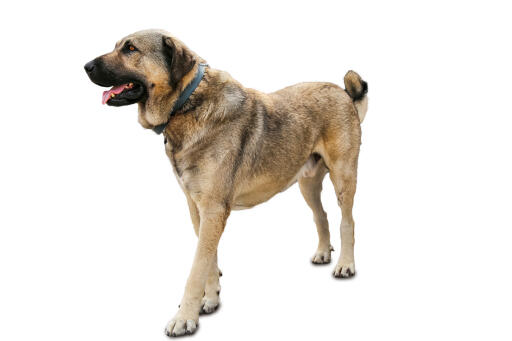Tyrkisk Kangal hund



History
The Turkish Kangal Dog is a large breed of dog originating from the Kangal region of Turkey. It was used as a protector of sheep and other livestock and was a fierce defender against wolves and other predators. Rarely left alone to guard sheep, it would work with the shepherd to deter and warn against attack. The breeding of the TKD is strictly controlled in Turkey and the isolation of the breed has meant that the pedigree is still pure.
Behaviour
The Kangal is devoted to it's family but can be very territorial. They are good with children and regular visitors to the home, but can be wary of strangers. This stems back to their guarding nature and it is vital to accustom them to new people, places and situations from a young age. They will want to protect you and will often stand and stare if they believe you are under threat. They try to intimidate others with their size when they aren't happy, but if forced, will attack if they think that is the only way. They are rarely aggressive towards people if they are socialised and understand their rank in the family pack.
Training should be started early on, with you being in control at all times. They need firm leadership and any sign of weakness they will spot immediately. They think that tricks are pointless, so you will have to be clever with training and make them think they want to do it. Starting with puppy classes and later adult classes will help control this large breed. They are loving and happy to be around you and will want to please you, but don't always understand what you want from them. Teaching them to heel is important and is the basics to having a well trained dog. Positive reinforcement, affection and food rewards work well. They are sensitive to changing situations, but adapt quite well.
The TKD needs a fair amount of exercise, but less that it's size would suggest. A long daily walk and chance to run around and explore will keep them happy, mentally and physically stimulated. They can make good jogging partners, but must run along side the owner, not in front. They are a good deterrent and their sheer size is enough to stop unwanted attention from strangers. They don't cope well in a small home and need a large garden with very secure fencing to prevent escape attempts. They will often dig a large hole in the garden to make a cool area to sleep in. Given enough exercise, they are calm in the home, but will always have one ear open to possibly intruders.
They mature slowly, but are considered fully grown by age 3. They like to chew and should be provided with bones to prevent them eating your home!
They shed their fur heavily twice and year and a decent brush will help remove a lot of the dead hair. They need little attention with brushing when not shedding.
They are no known health issues with the breed.
Temperament
Turkish Kangal Dogs have a protective and rugged temperament. Bred to protect flocks of sheep from wolves the Kangal makes a formiddable guard dog. The Kangal will form a tight bond with his family (including other pets) but will always be suspicious of strangers on its territory. It is particularly important with this breed that you assert yourself in training the dog so that it knows you are the ''pack leader''.
Health Problems
Health problems that may affect Turkish Kangal Dogs include canine hip dysplasia (CHD) and elbow dysplasia.
Breed Details
- Status: Common
- Life Expectancy: 12 - 15 years
- Vægt: 41 - 63 kg
- Højde: 28 - 33"
- Rare: Nej
- Coat: Lavt
- Grooming Requirements: Once a week
- Town or Country: Land
- Minimum Home Size: Large House
- Minimum Garden Size: Large Garden
- Breed Type: Herding
- Størrelse: Stor
- Energy Level: Medium
- Exercise Required: Over 2 hours
Billeder af Turkish Kangal Dog









